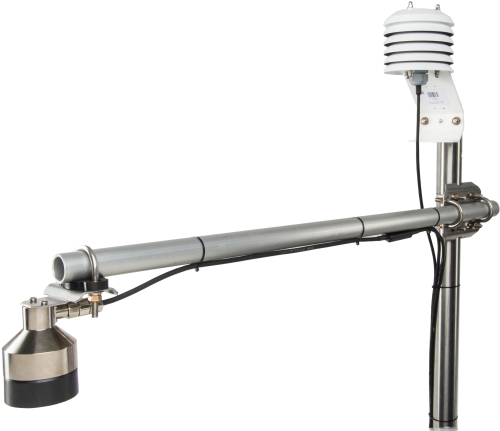This product is not available for new orders. We recommend ordering: SR50A-EE-L.

| Services Available | |
|---|---|
| Repair | Yes |
| Free Support | Yes |
Überblick
Die SR50A-Sensoren sind Ultraschall-Distanzsensoren zur Messung von z.B. Schneehöhe. Sie geben einen Ultraschall-Puls ab und bestimmen aus der Zeit bis zu Rückkehr des Pulses den Abstand zu einer Oberfläche. Es gibt verschiedene Version des SR50A:
Der SR50AT-316SS hat ein Gehäuse aus rostfreiem Stahl und einen beschichteten Transducer, wodurch er in mariner oder korrosiver Umgebung eingesetzt werden kann. Eine eingebaute Heizung im SR50ATH verhindert Eisbildung am Transducer. Die Sensoren der -AT Serie haben einen eingebauten Temperaturfühler zur Temperaturkorrektur der Werte (die Geschwindigkeit des Ultraschalls hängt von der Temperatur ab).
Lesen Sie mehr
Funktionen und Vorteile
- Integrated temperature probe for providing temperature correction of measurements
- Non-contact method for determining snow depth
- Wide operating temperature range
- Designed for marine or corrosive environments
- User-selectable options for output
- Uses a multiple echo processing algorithm to help ensure measurement reliability
- Compatible with most Campbell Scientific data loggers
Bilder



Zugehörige Produkte
Technische Beschreibung
The SR50AT-316SS was designed to meet the stringent requirements of measuring depths and uses a multiple echo processing algorithm to help ensure measurement reliability.
SDI-12, RS-232, and RS-485 output options are available for measuring the SR50AT-316SS. Campbell Scientific’s MD485 interface can be used to connect one or more SR50AT-316SS sensors in RS-485 mode to an RS-232 device. This can be useful for sensors that require lead lengths that exceed the limits of either RS-232 or SDI-12 communications. The SR50ATH-L is available with a heater option for locations where rime ice is a problem.
The SR50A replaced the SR50 in March 2007. The newer SR50A is smaller and has different output options than its predecessor.
Kompatibel mit
Please note: The following shows notable compatibility information. It is not a comprehensive list of all compatible products.
Datenlogger
| Product | Compatible | Note |
|---|---|---|
| CR1000 (retired) | SDI-12 and RS-232. For RS-485, requires an MD485 interface or similar RS-485 to RS-232 interface. | |
| CR1000X (retired) | SDI-12 and RS-232. For RS-485, requires an MD485 interface or similar RS-485 to RS-232 interface. | |
| CR200X (retired) | SDI-12 | |
| CR216X (retired) | SDI-12 | |
| CR300 (retired) | SDI-12 and RS-232. For RS-485, requires an MD485 interface or similar RS-485 to RS-232 interface. | |
| CR3000 | SDI-12 and RS-232. For RS-485, requires an MD485 interface or similar RS-485 to RS-232 interface. | |
| CR310 | SDI-12 and RS-232. For RS-485, requires an MD485 interface or similar RS-485 to RS-232 interface. | |
| CR5000 (retired) | SDI-12 and RS-232. For RS-485, requires an MD485 interface or similar RS-485 to RS-232 interface. | |
| CR6 | SDI-12, RS-232, and RS-485 | |
| CR800 (retired) | SDI-12 and RS-232. For RS-485, requires an MD485 interface or similar RS-485 to RS-232 interface. | |
| CR850 (retired) | SDI-12 and RS-232. For RS-485, requires an MD485 interface or similar RS-485 to RS-232 interface. | |
| CR9000X (retired) | SDI-12 and RS-232. For RS-485, requires an MD485 interface or similar RS-485 to RS-232 interface. |
Miscellaneous
| Product | Compatible | Note |
|---|---|---|
| GRANITE 6 (retired) | SDI-12 and RS-232. For RS-485, requires an MD485 interface or similar RS-485 to RS-232 interface. |
Additional Compatibility Information
Data Logger Considerations
One single-ended channel per probe is required; an excitation channel can be shared by several probes.
Spezifikationen
| Measurement Time | < 1.0 s |
| Output Options | SDI-12 version 1.3, RS-232, RS-485 (output options selected by configuring internal jumpers) |
| Baud Rates | 1200 to 38400 bps (RS-232, RS-485 modes) |
| Power Requirements | 9 to 18 Vdc (typically powered by data logger’s 12 Vdc power supply) |
| Measurement Range | 0.5 to 10 m (1.6 to 32.8 ft) |
| Beam Acceptance | ~30° |
| Resolution | 0.25 mm (0.01 in.) |
| Accuracy | ±1 cm (0.4 in.) or 0.4% of distance to target (whichever is greatest). Requires external temperature compensation. |
| Operating Temperature Range | -45° to +50°C |
| Compliance | CE Compliant |
| Temperature Accuracy |
|
| Diameter | 7.5 cm (3 in.) |
| Length | 10.1 cm (4.0 in.) |
| Weight | 795 g (28 oz) without cable |
| Cable Weight | 250 g (8.2 oz) for a 4.57-m (15-ft) cable |
Power Consumption |
|
| Active | 250 mA (typical) |
| Quiescent SDI-12 Mode | < 1.0 mA |
| Quiescent RS-232/RS-485 Modes |
|
Maximum Cable Length |
|
| -NOTE- | Cable lengths greater than 60 m require a heavier gage wire if the power supply drops below 11 Vdc. |
| SDI-12 | 60 m (200 ft) |
| RS-232 | 60 m (200 ft) Baud rates ≤ 9600 bps |
| RS-485 | 300 m (984 ft) |




